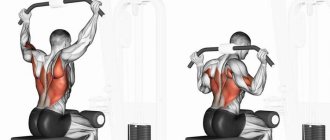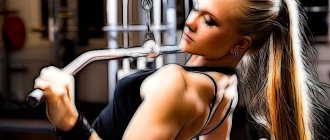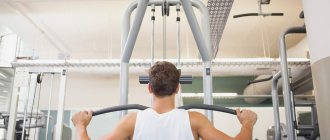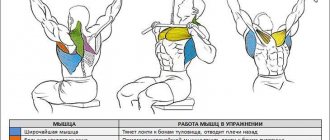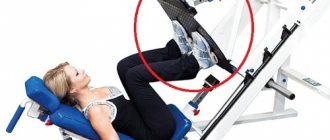Specifics of the exercise
The horizontal pull-down is a basic back exercise that targets the development of the latissimus dorsi muscles. To be fair, it should be placed in second place in the efficiency rating, right after universal pull-ups. But how many of you did pull-ups with ease in your first year of training? How many athletes can do 3-4 full sets of strict pull-ups?
For beginners, this is almost always an incomprehensible task. Therefore, horizontal, as well as vertical, traction should be the basis for the development of a powerful back. Otherwise, plans to quickly pump up will remain only at the level of desires and ideas.
I would like to pay special attention to the popular misconception that seated rowing is analogous to rowing. These are two separate exercises with different goals, so if you want to imitate the rowing motion of a cable machine, that would be a huge mistake. This way you won't get the lat load you need or the benefits of a rowing machine.
This exercise is worthy of becoming a staple for girls and women; it is ideal for rehabilitation and training at any age. The only recommendation I would like to give to beginners and even experienced athletes is not to use a belt. It is great for additional support of the lower back in standing exercises, but leads to unnecessary straining when performing movements while sitting. As a result, it provokes unwanted problems with the cardiovascular system.
What muscles work
In order for the exercise to bring maximum benefit, you need to clearly understand which muscles receive the main load. Without this, it is impossible to create a competent and balanced training program. The main muscles worked in the deadlift:
- Latissimus.
- Trapezoidal.
- Large diamond-shaped.
- Spinal extensors.
Additional load goes to the triceps, biceps, rear deltoids and chest. If the correct technique is observed, the main load will go to the latissimus muscles, the remaining groups work in a passive mode. When I see gym goers who, with all their might, pull the handle towards their waist with their hands, additionally helping themselves with their legs, I understand that without theory, practice is almost useless. Remember, the handle is not pulled by the biceps, but by the lats. Focus on the muscle, feel how it works, and then the pull will be effective.
The benefits and harms of exercise
The benefits of exercise are simply undeniable. This movement allows you to train your lats with heavy weights without harm or consequences. And most importantly - without axial load on the spine and other negative factors. Also, when doing this, a minimal load is placed on the lower back, so I recommend this exercise both for teenagers and when recovering from childbirth (but only with minimal weights, without straining and with the permission of a doctor).
To summarize, the main benefits of horizontal traction are:
- Safe work with heavy weights (which means increased production of anabolic hormones).
- Minimal risk of injury compared to other exercises.
- Improved posture.
I would not talk about the dangers of the exercise, especially considering that working with the lower block is considered the safest. In fact, this is an analogue of a bent-over barbell row, which allows you to fix the position and better control the position of the body.
However, there are two main disadvantages that can greatly reduce its effectiveness:
- Strong body swaying.
- Pull using the strength of your arms and shoulders, not your back.
Both disadvantages are caused by incorrect execution technique and incorrectly selected weight in the simulator.
Types of handles and grip method
Exercises on this simulator can be varied. The front row is performed in several grip styles, with different handle configurations. The features of the last elements are shown in the table.
| Handle type | Description | Additional Information |
| V-shaped | Suitable for classic block rows with a narrow grip | Recommended for performing exercises to work the latissimus dorsi and trapezius muscles |
| L shaped | Universal option for all grips | Allows you to work the muscles of the back, arms, deltas |
| Ropeway | Used with a neutral grip and variable hand position | Focused on pulling the block to the stomach or chest |
| Wide with curves | Designed for pulling the lower block with a wide grip, but you can also hold it in bending areas | When a wide grip is used, the range of motion decreases and the load on the biceps decreases. |
Working on a pulley with a lower row to develop the shoulder girdle is done by pulling the load to the chest with a wide grip. This makes it possible to emphasize the load in the right place. The technique is identical to the classic version, except for the angle and width of the handles.
It is recommended to perform lower rows of the block to the waist while sitting using special straps for the hands. This advice is relevant for most back muscle exercises. This approach allows you to remove excess tension from the forearms and radial areas of the wrists, directing the main effort to the part of the body being worked.
V-shaped
L shaped
Ropeway
Wide with curves
Correct technique and types of exercises
In bodybuilding, maintaining the correct technique is an axiom and a paramount rule (which is often violated, most often out of ignorance). Therefore, the better you comply with all the technical features, the greater the effect will be from performing each repetition in the approach. Now I will talk about the main types of deadlifts and their differences.
To the belly
This is a basic version of front traction, which is considered completely universal. I would like to note that performing the movement in a low crossover block is not considered a replacement. With this technique, the cable will not move horizontally, but from bottom to top. As a result, the load angle changes and other muscles will be involved in the work. If you sit on the floor and not on a bench, then doing the exercise will be uncomfortable. This option is suitable only if there is no special simulator (although I have not met a gym where it was not installed).
Performing a deadlift looks like this:
- Sit on a bench and rest your feet on the platforms so that your knees are slightly bent.
- Grab the short handle with a neutral, close grip (depending on the handle).
- Level your body and move it forward a little.
- Begin to slowly move the handle towards your stomach, slightly tilting your body back.
- At the peak point, squeeze your shoulder blades together as much as possible, then return the handle to the starting position.
I would like to emphasize that body sway should be minimal. Just to better stretch the lats.
To the chest
Performing rows to the chest allows you to shift the load from the lower part of the trapezius to the upper part, as well as to the shoulders. The latissimus muscles also receive the main load, but you need to pay attention to the deltoids so that they do not become overextended. If they are the weak link in the deadlift, you will not be able to lift heavy weights and will reduce the effectiveness of the exercise. A narrow handle is best, but if you have good shoulder mobility, you can do the exercise with a medium grip. In any case, a wide grip is not recommended due to the strong reduction in amplitude and increased load on the shoulders.
To the head
Bringing the handle to the face is more classified as shoulder movements, because the main load is significantly shifted to this muscle group. However, this row works well on the upper lats and rear deltoids. I recommend doing this option for those who have problems with posture. In this case, the ideal scheme would be to alternate classic rows in a sitting position and bringing the handle to the face (to the chin, to be more precise).
Sitting abdominal row
Separately, mention should be made of this exercise, which, judging by the reviews, allows you to work not only the muscles of the back and biceps, but also the deltoids with the muscles of the lower back and forearms.
It is performed almost the same as a regular deadlift. However, it differs from it in that during training the elbows go far behind the back. For this exercise, either a long handle or a V-shaped handle is installed on the machine, which depends on the purpose of the workout. The long handle should be grasped with a wide grip to pump up the upper back. On the contrary, the V-shaped handle is taken with a narrow grip in order to pump up the lower back.
The technique of seated abdominal thrusts itself involves: choosing a weight, sitting on the machine, stretching your legs all the way, and grasping the selected handle. Then, as you exhale, you should begin to pull your arms towards your stomach, trying to bring both elbows together behind your back. As soon as you feel that it is impossible to bring your arms together anymore, you should freeze for a couple of seconds, and then, while inhaling, return to the starting position. Naturally, the exercise should be performed the selected number of times, but not less than ten.
Example of a workout with the addition of horizontal rows
What is the proper training for seated deadlifts? To begin with, a complete warm-up of the whole body, even the legs. After this, it is better to switch to pull-ups or a vertical block as a replacement. Only then should you start deadlifting, when the muscles are sufficiently warmed up and you can push yourself to the maximum in heavy strength approaches. The entire back workout after warm-up and cardio will look like this:
- Pull-ups/vertical pull-downs with wide handles.
- Horizontal block traction.
- Bent-over barbell/dumbbell rows.
- Shrugs with dumbbells.
- Hyperextension.
If a deadlift is added, then it should be placed in the middle of the workout, and also perform 2 sets of hyperextension to warm up the lower back.
At home
Even without going to the gym, horizontal rowing is available to everyone. How to replace a bulky exercise machine? The answer is simple - rubber bands. Just secure them at the desired height and perform deadlifts just like you would in the gym. The movement can be performed with one hand for greater clarity and focus on the back.
Example workout:
- Warm up.
- Pull-ups on the horizontal bar.
- Horizontal pull of the rubber band.
- Shrugs with dumbbells.
The harness exercise can be alternated with bent-over dumbbell rows for weeks at a time.
In the gym
Perform deadlifts as usual, after 1-2 back exercises and a full warm-up. Choose the repetition mode depending on your training goals, but I do not recommend going beyond 3-5 sets.
Example of a gym workout:
- Weighted pull-ups/vertical rows.
- Lever row in the machine/dumbbell row in an incline position.
- Horizontal row in a block machine.
- Shrugs.
- Hyperextension.
Wide grip horizontal row
Judging by the reviews of athletes, the exercise allows you to thoroughly work out the middle part of the broad muscles. To perform it, you need to install the selected handle and weight on the simulator. Sit down and then grab the apparatus with a wide grip, which involves spreading your arms to a distance greater than shoulder width, placing your palms on top of the handle. Then we exhale the air and pull our hands to our stomach, without tilting our heads and straining our back and biceps muscles. You need to freeze in this position for a couple of seconds. And then all you have to do is inhale and return to the starting position. After this, continue to perform the exercise the required number of times.
Training Tips
Warm-up
Without a good warm-up, it’s better to get dressed and go home, because every movement can be traumatic. Stretch not only your back muscles, but also your entire upper body. A 4-5 minute warm-up and 5-10 minutes of light cardio at the beginning of the workout is enough.
Sets and reps
For beginner athletes, it is better to work in a repetition regime of 8 to 10.
For men, it's best to work in the 6-8 rep range to build strength and muscle mass. For girls, high-repetition work of 12-15 repetitions is ideal, but with a reduction to 8 in the last approaches and a gradual increase in weight.
The optimal number of approaches for deadlifts is from 3 to 5.
How to choose a working weight
You can only choose the right weight experimentally. Start small and try to get to a weight where you find it difficult to complete 5-6 reps. Based on this in subsequent workouts, but remember the progression of the load.
What grip to use
Regarding the position of the hand, it doesn’t matter. The lats will receive the same load in any case. Medium and wide grips are great for rowing, so you can better pull your shoulders back and retract your shoulder blades.
Nutrition and sports supplements
All these beautiful photos and videos of professional athletes who deadlift and get extraordinary relief are advertising fiction. Horizontal traction is needed for powerful power work. If you want to become slim, then you need to control your nutrition and diet. Exercise is nothing more than a mechanical element that forces the body to respond to stress. Of the mandatory sports supplements, I can only recommend protein and vitamin-mineral complexes. I advise men to add creatine to the list to increase strength and progression.
Common mistakes
The deadlift is an exercise with a minimal arsenal of mistakes, but gym goers try their best to use them. Here are the main ones:
- Excessive body sway.
- Lack of focus on the target muscle (latissimus).
- Incomplete retraction of the shoulder blades at the peak point.
- Rounding the back.
Each mistake significantly reduces the effectiveness of the exercise and can cause injury.
Close-grip horizontal pull-down
As athletes advise, you are better off using this exercise if you want to work your biceps rather than your back muscles. The technique for performing this exercise is almost completely the same as the wide-grip pull-down, but has some differences.
First of all, install the weight and handle on the machine, and sit down. And then you need to grab the handle so that the distance between your hands is similar to the size of your wrist. In addition, this time the palms are placed not on top of the projectile, but on the bottom.
Next, let's begin the exercise. To do this, you should lean your body a little forward, exhale and begin to move your body back, moving your hands towards your stomach. As soon as your hands are near your stomach, strain your back and biceps muscles, freeze for a couple of seconds and slowly return to the starting position. After this, we do the selected number of repetitions according to the training program.
Conclusion
Cable horizontal rows are a great exercise. It can be replaced with dumbbell rows or barbell rows, but you are unlikely to be able to work with the same weights and efficiency. The exercise is truly universal, effective and safe, so I strongly recommend including it in the training program for anyone who wants to have a developed back and good posture.
If this article was useful to you and you were able to take a completely different look at an exercise that you had previously done or excluded from your program, then it’s time to subscribe and share the article on social networks. I promise, there is still a lot of useful material ahead of you that will help you understand how to train correctly and how the fitness industry is filled with misconceptions and myths.

